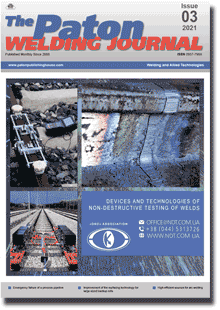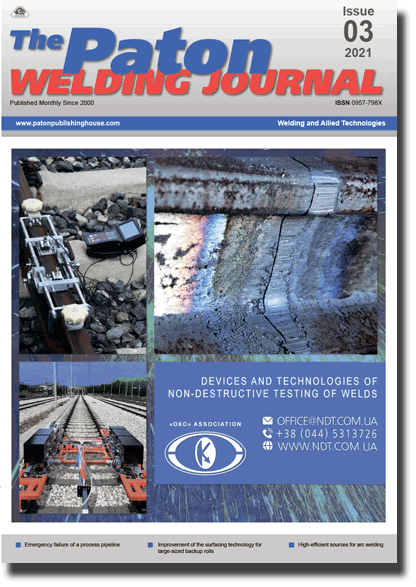| 2021 №03 (08) |
DOI of Article 10.37434/tpwj2021.03.01 |
2021 №03 (02) |

The Paton Welding Journal, 2021, #3, 2-8 pages
Fatigue life of steel 40Kh specimens after wear-resistant surfacing with a sublayer of low-carbon steel
І.О. Ryabtsev, V.V. Knysh, A.A. Babinets and S.O. Solovej
E.O. Paton Electric Welding Institute of the NASU. 11 Kazymyr Malevych Str., 03150, Kyiv, Ukraine. E-mail: office@paton.kiev.ua
Abstract
The resistance to fatigue fracture of steel 40Kh after wear-resistant surfacing using PP-Np-25Kh5FMS flux-cored wire with a sublayer of a low-carbon ductile material formed by Sv-08A wire was investigated. The design of the deposited specimens and the procedure of their testing simulated operating conditions of the mill rolls, for surfacing of which PP-Np-25Kh5FMS flux-cored wire is widely used. A comprehensive procedure for evaluating the resistance of multilayer material to fatigue fracture included three stages: determination of cyclic life of specimens after manufacturing surfacing; study of cyclic crack resistance of different metal layers; determination of fatigue life of specimens, which in the course of preliminary tests had fatigue cracks in the deposited layer after repair surfacing. It was established that the cyclic life of the specimens of carbon steel 40Kh, deposited using PP-Np-25Kh5FMS flux-cored wire with a sublayer of low-carbon steel 08kp (rimmed) exceeds the cyclic life of the specimens deposited without a sublayer, approximately by 2 times. The maximum values of stress intensity factor (SIF) (140‒180 MPa√m) obtained on the specimens with a multilayer surfacing with a sublayer, are 2‒3 times higher than the maximum values of SIF obtained on the specimens without a sublayer, which indicates the rationality of using a low-carbon sublayer to increase the crack resistance of a multilayer material with wear-resistant surfacing. It was shown that performance of repair surfacing according to the scheme of removal and a subsequent remelting of only areas of the metal with fatigue cracks of long-term operating parts does not lead to a significant increase in the cyclic life after repair. This is related to the fact that after long operation, the defect-free layer of deposited metal has a significant level of accumulated fatigue damages. Therefore, to increase the efficiency of repair surfacing, it is recommended to remove not only the metal around the detected fatigue cracks, but the entire deposited layer to the depth of detected fatigue cracks with the subsequent restoration surfacing. 18 Ref., 4 Tables, 7 Figures.
Keywords: arc surfacing, repair surfacing, ductile sublayer, fatigue life, fatigue cracks, stress intensity factor
Received 05.02.2021
References
1. Du Toit, M., Van Niekerk, J. (2010) Improving the Life of Continuous Casting Rolls Through Submerged Arc Cladding with Nitrogen-Alloyed Martensitic Stainless Steel. Welding in the World, 54 (11-12), 342-349. https://doi.org/10.1007/BF032667482. Vundru, C., Paul, S., Singh ,R., Yan, W. (2018) Numerical analysis of multi-layered laser cladding for die repair applications to determine residual stresses and hardness. Procedia Manufacturing, 26, 952-961. https://doi.org/10.1016/j.promfg.2018.07.122
3. Gao, F., Zhou, J., Zhou, J. et al. (2017) Microstructure and properties of surfacing layers of dies manufactured by bimetalgradient-layer surfacing technology before and after service. The International J. of Advanced Manufacturing Technology, 88, 1289-1297. DOI: https://doi.org/10.1007/s00170-016-8679-0
4. Zhang, J., Zhou, J., Tao, Y. et al. (2015) The microstructure and properties change of dies manufactured by bimetal-gradient-layer surfacing technology. Ibid, 80, 1807-1814 (2015). https://doi.org/10.1007/s00170-015-7170-7
5. Ahn, D.-G. (2013) Hardfacing technologies for improvement of wear characteristics of hot working tools: A Review. International J. of Precision Engineering and Manufacturing, 14 (7), 1271-1283. https://doi.org/10.1007/s12541-013-0174-z
6. Jhavar, S., Paul, C.P., Jain, N.K. (2013) Causes of failure and repairing options for dies and molds: A review. Engineering Failure Analysis, 34, 519-535. https://doi.org/10.1016/j.engfailanal.2013.09.006
7. Ryabtsev, I.O., Knysh, V.V., Babinets, A.A. et al. (2020) Fatigue life of specimens after wear-resistant, manufacturing and repair surfacing. The Paton Welding J., 9, 19-25. https://doi.org/10.37434/tpwj2020.09.03
8. Rjabcev, I.A., Senchenkov, I.K., Turyk, Je.V. (2015) Naplavka. Materialy, tehnologii, matematicheskoe modelirovanie [Surfacing. Materials, technologies, mathematical modeling]. Gliwice, Wydawnictwo politechniki slaskiej [in Russian].
9. Korotkov V.A. (2017) More efficient surfacing. Russian Engineering Research, 37, 701-703. https://doi.org/10.3103/S1068798X17080093
10. Shao, C., Cui, H., Lu, F., Li, Z. (2019) Quantitative relationship between weld defect characteristic and fatigue crack initiation life for high-cycle fatigue property. International J. of Fatigue, 123, 238-247. https://doi.org/10.1016/j.ijfatigue.2019.02.028
11. Liu, H., Yang, S., Xie, C. et al. (2018) Mechanisms of fatigue crack initiation and propagation in 6005A CMT welded joint. J. of Alloys and Compounds, 741, 188-196. https://doi.org/10.1016/j.jallcom.2017.12.374
12. Zerbst, U., Madia, M., Beier, H.T. (2017) Fatigue strength and life determination of weldments based on fracture mechanics. Procedia Structural Integrity, 7, 407-414. https://doi.org/10.1016/j.prostr.2017.11.106
13. Ryabtsev, I.A., Knysh, V.V., Babinets, A.A. et al. (2019) Methods and specimens for comparative investigations of fatigue resistance of parts with multilayer surfacing. The Paton Welding J., 2, 29-34. https://doi.org/10.15407/tpwj2019.02.05
14. Oberg, E. et al. (1996) Machinery`s Handbook (25th ed.), Industrial Press Inc.
15. (2004) Пристрій контролю механічних напружень та деформацій в твердих середовищах. Патент UА 71637 С2.
16. Kaierle, S., Overmeyer, L., Alfred, I. et al. (2017) Singlecrystal turbine blade tip repair by laser cladding and remelting. CIRP J. of Manufacturing Sci. and Technology, 19, 196-199. https://doi.org/10.1016/j.cirpj.2017.04.001
17. Caccese, V., Blomquist, P. A., Berube et al. (2006) Effect of weld geometric profile on fatigue life of cruciform welds made by laser/GMAW processes. Marine Structures, 19 (1), 1-22. https://doi.org/10.1016/j.marstruc.2006.07.002
18. Murakami, Yu. (1990) Reference book on stress intensity efficients. In: 2 Vol. Moscow, Mir [in Russian].
Suggested Citation
І.О. Ryabtsev, V.V. Knysh, A.A. Babinets and S.O. Solovej (2021) Fatigue life of steel 40Kh specimens after wear-resistant surfacing with a sublayer of low-carbon steel. The Paton Welding J., 03, 2-8.The cost of subscription/purchase order journals or individual articles
| Journal/Currency | Annual Set | 1 issue printed |
1 issue |
one article |
| TPWJ/USD | 384 $ | 32 $ | 26 $ | 13 $ |
| TPWJ/EUR | 348 € | 29 € | 24 € | 12 € |
| TPWJ/UAH | 7200 UAH | 600 UAH | 600 UAH | 280 UAH |
| AS/UAH | 1800 UAH | 300 UAH | 300 UAH | 150 UAH |
| AS/USD | 192 $ | 32 $ | 26 $ | 13 $ |
| AS/EUR | 180 € | 30 € | 25 € | 12 € |
| SEM/UAH | 1200 UAH | 300 UAH | 300 UAH | 150 UAH |
| SEM/USD | 128 $ | 32 $ | 26 $ | 13 $ |
| SEM/EUR | 120 € | 30 € | 25 € | 12 € |
| TDNK/UAH | 1200 UAH | 300 UAH | 300 UAH | 150 UAH |
| TDNK/USD | 128 $ | 32 $ | 26 $ | 13 $ |
| TDNK/EUR | 120 € | 30 € | 25 € | 15 € |
AS = «Automatic Welding» - 6 issues per year;
TPWJ = «PATON WELDING JOURNAL» - 12 issues per year;
SEM = «Electrometallurgy Today» - 4 issues per year;
TDNK = «Technical Diagnostics and Non-Destructive Testing» - 4 issues per year.


